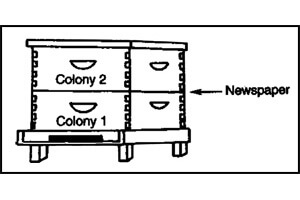
Welcome to our third and final segment on teaching and mentoring beekeepers. Seasonal apiary management has a general sequence that is a good addition to any course regarding bees. There is a way to make each task fit the region where bees are kept. In order to adapt, it pays to become familiar with A. D. Hopkins’ bioclimatic law. A.D. Hopkins discovered that spring is delayed one day for every 15 minutes of latitude northward, 5 days for each 4 degrees of longitude westward, and one day for every 100 feet higher in elevation in North America east of the Rocky Mountains.
Thus, for a site located 15 minutes of latitude north, 5 degrees longitude west and 100 feet higher than another chosen site, spring should arrive 6 days later. So let us compare North Minnesota to South Georgia: according to A. D. Hopkins Bioclimatic Law, flowers should bloom, trees should bud, and bees begin brood rearing 76 days later. The reason is the numbers; Minnesota near Brainerd is approximately 16 degrees latitude farther north, 12 degrees longitude farther west and about 800 feet higher in elevation than Uvalda, Georgia. Check it out. When Redbud begins to bloom near you, go 100 feet higher, 15 minutes north or one full degree west and those Redbuds will be a day behind.
As we can deduce, there are about 2 ½ months difference between the Northern and Southern United States. Local Beekeepers will know about when honey plants begin to bloom and the bees start to stir. The students will be better served if the instructor knows that elevation makes a big difference in the climate. Also, the distance east or west, north or south in any state will cause a significant difference in climate conditions. Since many beekeeping courses are statewide, any instructor needs to know the climate variation as well as local conditions. As we list the different months that certain maintenance tasks are accomplished, keep in mind the climate differences at your location and state. The suggestions in this article may occur earlier or later, depending on your geographic location.
The winter is a good place to begin. Beekeeping is a slower activity during winter. Other than feeding, most beekeeping time is devoted to equipment. First, it is a good time to build new equipment, repair equipment and paint equipment. I like to inspect my apiary about once each week in winter. Animal and weather damage occur this time of year. If anything happens to any hive, it is best to know it before activity increases in the spring. A big snow can confine bees in the north. Animals can turn over or damage hives while seeking honey as food. Winter (December and January) is a good time to render wax for sale or exchange. Bees may need sugar water and/or pollen substitute. If a colony has less than 15 pounds of honey (six frames of honey in a shallow super or 3 frames in a deep hive body) then feeding them becomes an emergency.
February is often the month for moving bees to pollinate fruit. In much of the country, queens will begin to lay eggs in February. This is a time to feed ample pollen or pollen substitute. Feed sugar water as spring begins only if you want a rapid increase in bee population. This will help if you wish to make splits for colony increase. Feeding sugar in February and March over much of the U. S. can cause swarming if you do not split your colonies. It is also advisable to combine weak colonies before the spring gets into full swing as bees collect nectar and pollen. Kill the less desirable queen or leave both queens in the combined hive. You can let the bees choose the queen between two. The strongest colony should have the better queen.
A single sheet of newspaper should be laid over the brood frames in the stronger colony. If you keep bees in two deep hive bodies or two medium hive bodies, then the lower one may be empty. Weak colonies often fill the upper hive box and leave the lower one empty. Place the newspaper directly upon the brood frames where you want the combined hive to sit. Set the queen-less brood nest on top of the newspaper. A single slit in the newspaper between two middle frames will give the bees a place to start moving the unwanted newspaper from their hive. The two colonies will merge into one larger colony. This often saves a single honey-producing hive and prevents the loss of two weak colonies.
If the temperature is above 50 degrees F., check capped drone brood for Varroa mites. This is also a good time to use a …
Photo Caption
Unite weak colonies


